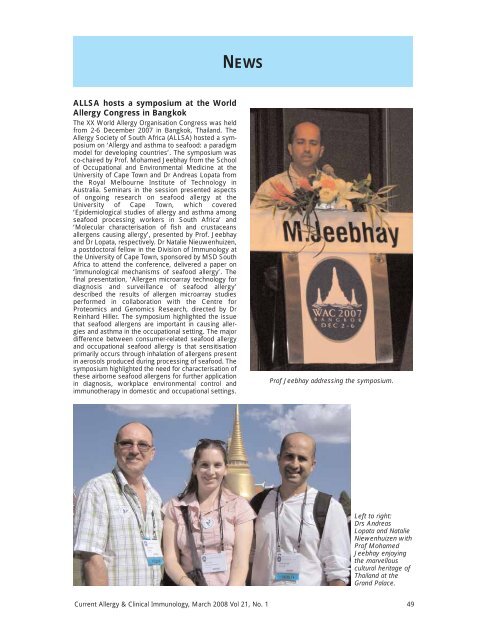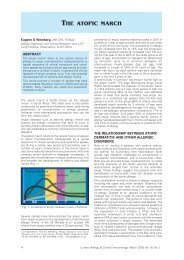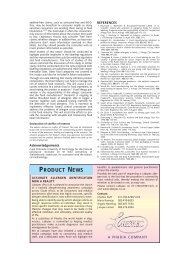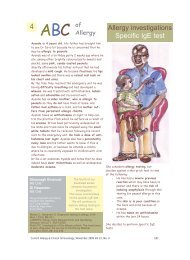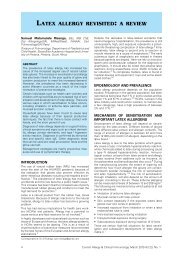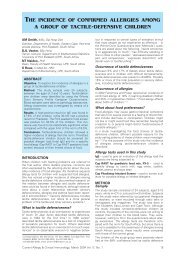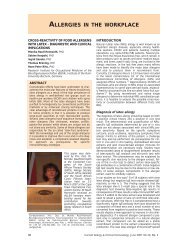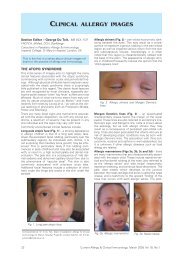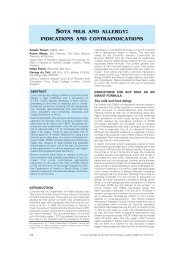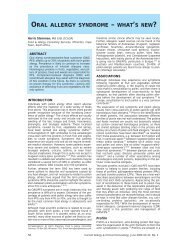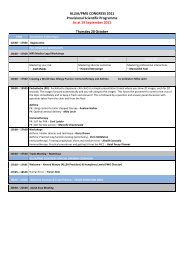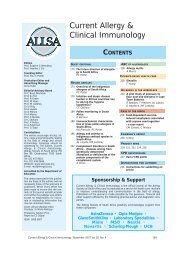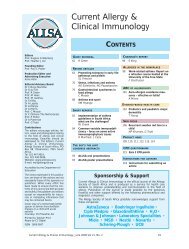Current Allergy and Clinical Immunology - March 2008
Current Allergy and Clinical Immunology - March 2008
Current Allergy and Clinical Immunology - March 2008
Create successful ePaper yourself
Turn your PDF publications into a flip-book with our unique Google optimized e-Paper software.
NEWSALLSA hosts a symposium at the World<strong>Allergy</strong> Congress in BangkokThe XX World <strong>Allergy</strong> Organisation Congress was heldfrom 2-6 December 2007 in Bangkok, Thail<strong>and</strong>. The<strong>Allergy</strong> Society of South Africa (ALLSA) hosted a symposiumon ‘<strong>Allergy</strong> <strong>and</strong> asthma to seafood: a paradigmmodel for developing countries’. The symposium wasco-chaired by Prof. Mohamed Jeebhay from the Schoolof Occupational <strong>and</strong> Environmental Medicine at theUniversity of Cape Town <strong>and</strong> Dr Andreas Lopata fromthe Royal Melbourne Institute of Technology inAustralia. Seminars in the session presented aspectsof ongoing research on seafood allergy at theUniversity of Cape Town, which covered‘Epidemiological studies of allergy <strong>and</strong> asthma amongseafood processing workers in South Africa’ <strong>and</strong>‘Molecular characterisation of fish <strong>and</strong> crustaceansallergens causing allergy’, presented by Prof. Jeebhay<strong>and</strong> Dr Lopata, respectively. Dr Natalie Nieuwenhuizen,a postdoctoral fellow in the Division of <strong>Immunology</strong> atthe University of Cape Town, sponsored by MSD SouthAfrica to attend the conference, delivered a paper on‘Immunological mechanisms of seafood allergy’. Thefinal presentation, ‘Allergen microarray technology fordiagnosis <strong>and</strong> surveillance of seafood allergy’described the results of allergen microarray studiesperformed in collaboration with the Centre forProteomics <strong>and</strong> Genomics Research, directed by DrReinhard Hiller. The symposium highlighted the issuethat seafood allergens are important in causing allergies<strong>and</strong> asthma in the occupational setting. The majordifference between consumer-related seafood allergy<strong>and</strong> occupational seafood allergy is that sensitisationprimarily occurs through inhalation of allergens presentin aerosols produced during processing of seafood. Thesymposium highlighted the need for characterisation ofthese airborne seafood allergens for further applicationin diagnosis, workplace environmental control <strong>and</strong>immunotherapy in domestic <strong>and</strong> occupational settings.Prof Jeebhay addressing the symposium.Left to right:Drs AndreasLopata <strong>and</strong> NatalieNiewenhuizen withProf MohamedJeebhay enjoyingthe marvellouscultural heritage ofThail<strong>and</strong> at theGr<strong>and</strong> Palace.<strong>Current</strong> <strong>Allergy</strong> & <strong>Clinical</strong> <strong>Immunology</strong>, <strong>March</strong> <strong>2008</strong> Vol 21, No. 1 49


